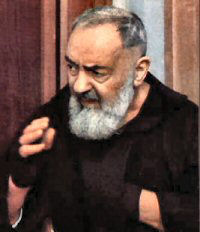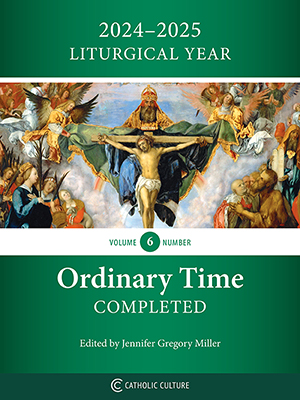Ordinary Time: September 23rd
Memorial of St. Padre Pio
Other Commemorations: St. Linus, Pope and Martyr (RM); Sts. Zechariah and Elizabeth (RM) ; Other Titles: Padre Pio of Pietrelcina; Francesco Forgione
» Enjoy our Liturgical Seasons series of e-books!
Padre Pio was born in 1887 in the small Italian village of Pietrelcina. He joined the Capuchin Friars at the age of sixteen and was ordained a priest seven years later. For fifty years at the monastery of San Giovanni Rotundo he was a much sought after spiritual advisor, confessor, and intercessor whose life was devoted to the Eucharist and prayer. Yet despite such notoriety, he would often say, "I only want to be a poor friar who prays."
According to the 1962 Missal of Bl. John XXIII the Extraordinary Form of the Roman Rite, today is the feast of St. Linus, the immediate successor of St. Peter in the government of the Church. He is mentioned after the apostles in the Roman Canon of the Mass (Eucharistic Prayer I). It is also the feast of St. Thecla, a virgin of Asia Minor in the early days of the Church. Her cultus, which is very ancient, goes back to the second century. She is considered the first woman martyr.
St. Pio or Pius of Pietrelcina
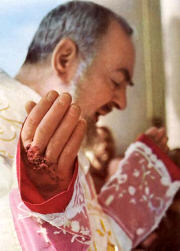 Born to a southern Italian farm family, the son of Grazio, a shepherd. At age 15 he entered the novitiate of the Capuchin Friars in Morcone, and joined the order at age 19. He suffered several health problems, and at one point his family thought he had tuberculosis. He was ordained at age 22 on 10 August 1910.
Born to a southern Italian farm family, the son of Grazio, a shepherd. At age 15 he entered the novitiate of the Capuchin Friars in Morcone, and joined the order at age 19. He suffered several health problems, and at one point his family thought he had tuberculosis. He was ordained at age 22 on 10 August 1910.
While praying before a cross on September 20, 1918, Padre Pio received the stigmata. He is the first priest ever to be so blessed. As word spread, especially after American soldiers brought home stories of Padre Pio following WWII, the priest himself became a point of pilgrimage for both the pious and the curious. He would hear confessions by the hour, reportedly able to read the consciences of those who held back. He was reportedly able to bi-locate, levitate, and heal by touch.
In 1956 he founded the House for the Relief of Suffering, a hospital that serves 60,000 a year. Padre Pio died on September 23, 1968 at age 81.
Today there are over 400,000 members worldwide in prayer groups begun by Padre Pio in the 1920s.
His canonization miracle involved the cure of Matteo Pio Colella, age 7, the son of a doctor who works in the House for Relief of Suffering, the hospital in San Giovanni Rotondo. On the night of June 20, 2000, Matteo was admitted to the intensive care unit of the hospital with meningitis. By morning doctors had lost hope for him as nine of the boy's internal organs had ceased to give signs of life. That night, during a prayer vigil attended by Matteo's mother and some Capuchin friars of Padre Pio's monastery, the child's condition improved suddenly. When he awoke from the coma, Matteo said that he had seen an elderly man with a white beard and a long, brown habit, who said to him: "Don't worry, you will soon be cured." The miracle was approved by the Congregation and Pope John Paul II on 20 December 2001.
—Adapted from the Discount Catholic Store, Inc.
Highlights and Things to Do:
- St. Pio is a saint of the last century, so there are many pictures and biographies to read more about his life. Having this gift of the stigmata was very hard on his life — both physically and emotionally. Find out more about the stigmata and his other mystical gifts, such as bilocation. St. Pio also had great devotion to his guardian angel.
- From the Catholic Culture library: Biography of Padre Pio of Pietrelcina, The Devil and Padre Pio, Five Maxims for Living a Devout Life and His Wounds Spoke of God's Love for All. There are many other documents in the library which may be found by searching for "pio".
- Read more about St. Padre Pio:
- The remains of St. Pio rest in the crypt below Santuario di San Pio da Pietrelcina in San Giovanni Rotondo, Italy.
- Visit the Padre Pio Shrine in New York City.
- See Catholic Cuisine for some original feast day food ideas.
St. Linus
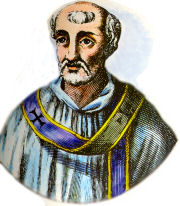 Following the crucifixion of Peter, Linus, who had served as an assistant to the apostle, continued the leadership of the Church, for once the Christian faith had been firmly established in Rome, Peter and Paul had commended Linus to this responsibility. However, because the one-man episcopate had not yet emerged in Rome, we have no way of knowing exactly what duties were expected of Linus. In a letter directed to the Oriental churches, Linus told how Peter's body was taken from the cross by Marcellus, bathed in milk and wine, and embalmed with precious spices.
Following the crucifixion of Peter, Linus, who had served as an assistant to the apostle, continued the leadership of the Church, for once the Christian faith had been firmly established in Rome, Peter and Paul had commended Linus to this responsibility. However, because the one-man episcopate had not yet emerged in Rome, we have no way of knowing exactly what duties were expected of Linus. In a letter directed to the Oriental churches, Linus told how Peter's body was taken from the cross by Marcellus, bathed in milk and wine, and embalmed with precious spices.
Linus, believed to be the son of Herculanus, was an Italian from the region of Tuscany. He has been identified by the early writer, Eusebius, as the same Linus who is mentioned by St. Paul in his letter of salutation from Rome to Timothy in Ephesus. His episcopate is said to have been approximately twelve years. A brief respite from persecution for the brethren is said to have existed at this time, for legend has it that Nero, in a frightening vision, was so chastised by Peter that he abandoned the wrath which he had once so fiercely set upon the Christians.
Much is unknown of Linus, to be sure, but it is said that he, at Peter's direction, decreed that all women would now cover their heads when entering a church. In the ancient canon of the Mass, his name is cited after those of Peter and Paul.
According to legend, Linus was martyred and buried on the Vatican Hill alongside his beloved Peter.
—Excerpted from The Popes: A Papal History, J.V. Bartlett
Symbols and Representation: Triple cross; fleeing demons.
Highlights and Things To Do:
- Read more about St. Linus:
- It is thought that Linus is buried in the Vatican. See List of Popes buried in St. Peter's and Wikipedia for further information.
St. Elizabeth
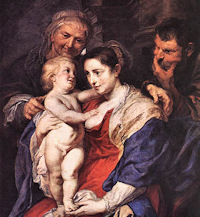 The name Elizabeth, which has been borne by several saints, means in Hebrew "worshiper of God." All that we know of Elizabeth, wife of Zachary and mother of John the Baptist, is to be found in the book of Luke. A descendant of the priestly line of Aaron, she was a kinswoman — how close we are not told — of the Virgin Mary.
The name Elizabeth, which has been borne by several saints, means in Hebrew "worshiper of God." All that we know of Elizabeth, wife of Zachary and mother of John the Baptist, is to be found in the book of Luke. A descendant of the priestly line of Aaron, she was a kinswoman — how close we are not told — of the Virgin Mary.
According to the Gospel, Elizabeth had lived a blameless life with her husband in one of the hill-towns of Judea. Having reached an advanced age with her prayers for a son unanswered, she thought that her barrenness was a reproach. One day, while Zachary was serving in the temple, the Angel Gabriel appeared at the right of the altar, and announced that a son would be born to Elizabeth. It was in the sixth month of her pregnancy that the Virgin Mary came to visit her — a touching and beautiful scene pictured by many great artists.
The Angel Gabriel, having lately announced to Mary the destiny that awaited her, also told her that her kinswoman Elizabeth was with child. The Virgin Mary, eager to share in Elizabeth's happiness and to confide that she too would bear a child, traveled down the dusty road from Nazareth. On Mary's arrival, she was amazed when Elizabeth, having foreseen knowledge, greeted her as "mother of my Lord." Elizabeth's salutation was in these words: "Blessed art thou among women and blessed is the fruit of thy womb. And how have I deserved that the mother of my Lord should come to me? For behold, the moment that the sound of thy greeting came to my ears, the babe in my womb leapt for joy. And blessed is she who has believed, because the things promised her by the Lord shall be accomplished."
The Gospel story tells us further that at Elizabeth's delivery her friends and neighbors rejoiced with her, and when the child was brought to be circumcised, they were going to call him after his father Zachary, but his mother said, "His name shall be John."
—Excerpted from Lives of Saints, Published by John J. Crawley & Co., Inc.
Patronage: expectant mothers, diocese of Fulda, Germany
Often Depicted As: elderly woman holding the infant John the Baptist; pregnant woman with the Virgin Mary; in the company of Saint Zachary
St. Zachary
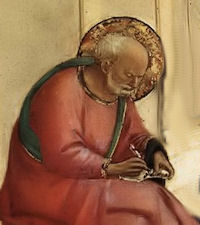 St. Zachary, whose feast is celebrated on the same day as that of St. Elizabeth, his wife, was of the tribe of Abia, and a member of the priestly class. It was customary for the priests whose week it was to serve in the temple to cast lots each day for the performance of the various rituals. One day, during Zachary's period of service, the privilege of offering incense on the altar in the holy place fell to him, and while he was alone before the altar performing this rite, the Angel Gabriel appeared to him, standing at the right of the altar. Zachary was troubled and afraid. Then Gabriel spoke, saying that the prayers of the priest and his wife would be answered; a son was to be born to them, and his name was to be John. Zachary found this hard to believe, for both he and Elizabeth were advanced in years. Overcoming his fear, he asked the angel for some sign. Because he doubted, the angel announced that Zachary would be stricken dumb and would regain the power of speech only when the prophecy was fulfilled. Then the angel disappeared and Zachary came forth from the temple. The people saw that he was unable to speak and they knew then that he had received a vision from the Lord.
St. Zachary, whose feast is celebrated on the same day as that of St. Elizabeth, his wife, was of the tribe of Abia, and a member of the priestly class. It was customary for the priests whose week it was to serve in the temple to cast lots each day for the performance of the various rituals. One day, during Zachary's period of service, the privilege of offering incense on the altar in the holy place fell to him, and while he was alone before the altar performing this rite, the Angel Gabriel appeared to him, standing at the right of the altar. Zachary was troubled and afraid. Then Gabriel spoke, saying that the prayers of the priest and his wife would be answered; a son was to be born to them, and his name was to be John. Zachary found this hard to believe, for both he and Elizabeth were advanced in years. Overcoming his fear, he asked the angel for some sign. Because he doubted, the angel announced that Zachary would be stricken dumb and would regain the power of speech only when the prophecy was fulfilled. Then the angel disappeared and Zachary came forth from the temple. The people saw that he was unable to speak and they knew then that he had received a vision from the Lord.
Elizabeth conceived and gave birth to the one who was to be the Precursor of the Lord. After eight days, when the child was about to be circumcised, Elizabeth told the people that he was to be named John; and Zachary, still unable to speak, asked for a tablet, and on it he wrote the words, "John is his name." At this moment Zachary's tongue was loosed, and he began to praise the Lord. The New Testament tells us nothing further concerning St. Zachary. In Hebrew his name means "Jehovah hath remembered."
—Excerpted from Lives of Saints, Published by John J. Crawley & Co., Inc.
Highlights and Things To Do:
- How beautiful that from the lips of Elizabeth and Zechariah we have parts of prayers that are prayed universally throughout the ages: Elizabeth's praise: "Blessed are you among women and blessed is the fruit of your womb!" became part of the Hail Mary and Zechariah's praise after his tongue was looked became the Canticle Benedictus, prayed every day for Morning Prayer in the Divine Office.
- Read more about Zechariah and Elizabeth:
- See the National Gallery of Art for a close-up on The Visitation with Saints Nicholas and Anthony Abbot by Piero di Cosimo.


